Optimal Operation of Integrated Electrical and Natural Gas Networks with a Focus on Distributed Energy Hub Systems
Abstract
1. Introduction
- Proposing a novel optimal operation of integrated regional electrical and natural gas networks, considering security constraints pertaining to AC-power flow and gas flow in pipelines, to achieve a more realistic model.
- Incorporating the interconnected energy hubs as connection points among multiple carriers to supply both electrical and thermal loads that are equipped with CHP, boiler, heat pump, and electrical and thermal storage systems. In this way, IEH systems can be considered a promising option to decentralize load management.
- Proposing a scenario-based stochastic approach to handle the uncertainty of real-time price, wind energy, as well as electrical loads in the integrated power and gas system’s operation.
- Analyzing the electricity and heating procurement of each IEH on the proposed scheduling to reveal their effects on the daily energy exchanged.
2. Problem Description
Interconnected Energy Hub
3. Problem Formulation
3.1. Objective Function
3.2. Problem Constraints
3.2.1. NG-Fired Unit Constraints
3.2.2. CHP Unit Constraints
3.2.3. Boiler Unit Constraints
3.2.4. Thermal Energy Storage (TES) Constraints
3.2.5. Battery Constraints
3.2.6. Heat Pump Constraints
3.2.7. Transformer Constraints
3.2.8. Power Flow and Distribution of Electrical Network Constraints
3.2.9. NG Network Constraints
3.2.10. Wind Power Modeling
3.2.11. Load Curtailment Constraints
4. Simulation and Numerical Results
Case Study
5. Conclusions
Author Contributions
Funding
Acknowledgments
Conflicts of Interest
References
- He, Y.; Yan, M.; Shahidehpour, M.; Li, Z.; Guo, C.; Wu, L.; Ding, Y. Decentralized Optimization of Multi-Area Electricity-Natural Gas Flows Based on Cone Reformulation. IEEE Trans. Power Syst. 2017, 33, 4531–4542. [Google Scholar] [CrossRef]
- Hemmati, M.; Mohammadi-Ivatloo, B.; Ghasemzadeh, S.; Reihani, E. Risk-based optimal scheduling of reconfigurable smart renewable energy based microgrids. Int. J. Electr. Power Energy Syst. 2018, 101, 415–428. [Google Scholar] [CrossRef]
- Demissie, A.; Zhu, W.; Belachew, C.T. A multi-objective optimization model for gas pipeline operations. Comput. Chem. Eng. 2017, 100, 94–103. [Google Scholar] [CrossRef]
- Schweiger, J.; Liers, F. A decomposition approach for optimal gas network extension with a finite set of demand scenarios. Optim. Eng. 2018, 19, 297–326. [Google Scholar] [CrossRef]
- Zhao, B.; Conejo, A.J.; Sioshansi, R. Unit Commitment Under Gas-Supply Uncertainty and Gas-Price Variability. IEEE Trans. Power Syst. 2016, 32, 2394–2405. [Google Scholar] [CrossRef]
- Shams, M.H.; Shahabi, M.; Khodayar, M.E. Stochastic day-ahead scheduling of multiple energy Carrier microgrids with demand response. Energy 2018, 155, 326–338. [Google Scholar] [CrossRef]
- Misra, S.; Fisher, M.W.; Backhaus, S.; Bent, R.; Chertkov, M.; Pan, F. Optimal Compression in Natural Gas Networks: A Geometric Programming Approach. IEEE Trans. Control Netw. Syst. 2014, 2, 47–56. [Google Scholar] [CrossRef]
- Shao, C.; Shahidehpour, M.; Wang, X.; Wang, X.; Wang, B. Integrated Planning of Electricity and Natural Gas Transportation Systems for Enhancing the Power Grid Resilience. IEEE Trans. Power Syst. 2017, 32, 4418–4429. [Google Scholar] [CrossRef]
- Badakhshan, S.; Ehsan, M.; Shahidehpour, M.; Hajibandeh, N.; Shafie-Khah, M.; Catalao, J.P.S. Security-Constrained Unit Commitment With Natural Gas Pipeline Transient Constraints. IEEE Trans. Smart Grid 2019, 11, 118–128. [Google Scholar] [CrossRef]
- AlAbdulwahab, A.; Abusorrah, A.; Zhang, X.; Shahidehpour, M. Coordination of Interdependent Natural Gas and Electricity Infrastructures for Firming the Variability of Wind Energy in Stochastic Day-Ahead Scheduling. IEEE Trans. Sustain. Energy 2015, 6, 606–615. [Google Scholar] [CrossRef]
- Zhang, X.; Shahidehpour, M.; AlAbdulwahab, A.; Abusorrah, A. Hourly Electricity Demand Response in the Stochastic Day-Ahead Scheduling of Coordinated Electricity and Natural Gas Networks. IEEE Trans. Power Syst. 2015, 31, 592–601. [Google Scholar] [CrossRef]
- Qadrdan, M.; Wu, J.; Jenkins, N.; Ekanayake, J. Operating Strategies for a GB Integrated Gas and Electricity Network Considering the Uncertainty in Wind Power Forecasts. IEEE Trans. Sustain. Energy 2013, 5, 128–138. [Google Scholar] [CrossRef]
- Ramírez-Elizondo, L.M.; Paap, G.B. Scheduling and control framework for distribution-level systems containing multiple energy carrier systems: Theoretical approach and illustrative example. Int. J. Electr. Power Energy Syst. 2015, 66, 194–215. [Google Scholar] [CrossRef]
- Xu, X.; Jia, H.-J.; Chiang, H.-D.; Yu, D.C.; Wang, D. Dynamic Modeling and Interaction of Hybrid Natural Gas and Electricity Supply System in Microgrid. IEEE Trans. Power Syst. 2015, 30, 1212–1221. [Google Scholar] [CrossRef]
- Boulmrharj, S.; Khaidar, M.; Bakhouya, M.; Ouladsine, R.; Siniti, M.; Zine-Dine, K. Performance Assessment of a Hybrid System with Hydrogen Storage and Fuel Cell for Cogeneration in Buildings. Sustainability 2020, 12, 4832. [Google Scholar] [CrossRef]
- Correa-Posada, C.M.; Sanchez-Martin, P. Security-Constrained Optimal Power and Natural-Gas Flow. IEEE Trans. Power Syst. 2014, 29, 1780–1787. [Google Scholar] [CrossRef]
- AlAbdulwahab, A.; Abusorrah, A.; Zhang, X.; Shahidehpour, M. Stochastic Security-Constrained Scheduling of Coordinated Electricity and Natural Gas Infrastructures. IEEE Syst. J. 2015, 11, 1674–1683. [Google Scholar] [CrossRef]
- Mirzaei, M.A.; Nazari-Heris, M.; Zare, K.; Mohammadi-Ivatloo, B.; Marzband, M.; Asadi, S.; Anvari-Moghaddam, A. Evaluating the impact of multi-carrier energy storage systems in optimal operation of integrated electricity, gas and district heating networks. Appl. Therm. Eng. 2020, 176, 115413. [Google Scholar] [CrossRef]
- Mirzaei, M.A.; Nazari-Heris, M.; Mohammadi-Ivatloo, B.; Zare, K.; Marzband, M.; Anvari-Moghaddam, A. A Novel Hybrid Framework for Co-Optimization of Power and Natural Gas Networks Integrated With Emerging Technologies. IEEE Syst. J. 2020, 14, 3598–3608. [Google Scholar] [CrossRef]
- Qadrdan, M.; Ameli, H.; Strbac, G.; Jenkins, N. Efficacy of options to address balancing challenges: Integrated gas and electricity perspectives. Appl. Energy 2017, 190, 181–190. [Google Scholar] [CrossRef]
- Manshadi, S.D.; Khodayar, M.E. Resilient Operation of Multiple Energy Carrier Microgrids. IEEE Trans. Smart Grid 2015, 6, 2283–2292. [Google Scholar] [CrossRef]
- Moeini-Aghtaie, M.; Abbaspour, A.; Fotuhi-Firuzabad, M.; Hajipour, E. A Decomposed Solution to Multiple-Energy Carriers Optimal Power Flow. IEEE Trans. Power Syst. 2013, 29, 707–716. [Google Scholar] [CrossRef]
- La Scala, M.; Vaccaro, A.; Zobaa, A.F. A goal programming methodology for multi-objective optimization of distributed energy hubs operation. Appl. Therm. Eng. 2014, 71, 658–666. [Google Scholar] [CrossRef]
- Najafi, A.; Falaghi, H.; Contreras, J.; Ramezani, M. Medium-term energy hub management subject to electricity price and wind uncertainty. Appl. Energy 2016, 168, 418–433. [Google Scholar] [CrossRef]
- He, C.; Wu, L.; Liu, T.; Wei, W.; Wang, C. Co-optimization scheduling of interdependent power and gas systems with electricity and gas uncertainties. Energy 2018, 159, 1003–1015. [Google Scholar] [CrossRef]
- Qi, F.; Shahidehpour, M.; Wen, F.; Li, Z.; He, Y.; Yan, M. Decentralized Privacy-Preserving Operation of Multi-Area Integrated Electricity and Natural Gas Systems With Renewable Energy Resources. IEEE Trans. Sustain. Energy 2019, 11, 1785–1796. [Google Scholar] [CrossRef]
- Kim, D.; Kim, K.-T.; Park, Y.-K. A Comparative Study on the Reduction Effect in Greenhouse Gas Emissions between the Combined Heat and Power Plant and Boiler. Sustainability 2020, 12, 5144. [Google Scholar] [CrossRef]
- Favre-Perrod, P. A vision of future energy networks. In Proceedings of the Inaugural IEEE PES 2005 Conference and Exposition in Africa; Institute of Electrical and Electronics Engineers (IEEE), Durban, South Africa, 11–15 July 2005; pp. 13–17. [Google Scholar]
- Geidl, M.; Koeppel, G.; Favre-Perrod, P.; Klockl, B.; Andersson, G.; Frohlich, K. Energy hubs for the future. IEEE Power Energy Mag. 2006, 5, 24–30. [Google Scholar] [CrossRef]
- Geidl, M.; Andersson, G. Optimal Power Flow of Multiple Energy Carriers. IEEE Trans. Power Syst. 2007, 22, 145–155. [Google Scholar] [CrossRef]
- Shahmohammadi, A.; Moradi-Dalvand, M.; Ghasemi, H.; Ghazizadeh, M.S. Optimal design of multi-carrier energy systems considering reliability constraints. IEEE Trans. Power Deliv. 2014, 30, 878–886. [Google Scholar] [CrossRef]
- Mirzaei, M.A.; Hemmati, M.; Zare, K.; Abapour, M.; Mohammadi-Ivatloo, B.; Marzband, M.; Anvari-Moghaddam, A. A novel hybrid two-stage framework for flexible bidding strategy of reconfigurable micro-grid in day-ahead and real-time markets. Int. J. Electr. Power Energy Syst. 2020, 123, 106293. [Google Scholar] [CrossRef]
- Bucher, M.A.; Haring, T.W.; Bosshard, F.; Andersson, G. Modeling and economic evaluation of Power2Gas technology using energy hub concept. In Proceedings of the 2015 IEEE Power & Energy Society General Meeting; Institute of Electrical and Electronics Engineers (IEEE), Denver, CO, USA, 26–30 July 2016; pp. 1–5. [Google Scholar]
- Zhang, X.; Shahidehpour, M.; AlAbdulwahab, A.; Abusorrah, A. Optimal Expansion Planning of Energy Hub With Multiple Energy Infrastructures. IEEE Trans. Smart Grid 2015, 6, 2302–2311. [Google Scholar] [CrossRef]
- Yuan, Z.; He, S.; Alizadeh, A.; Nojavan, S.; Jermsittiparsert, K. Probabilistic scheduling of power-to-gas storage system in renewable energy hub integrated with demand response program. J. Energy Storage 2020, 29, 101393. [Google Scholar] [CrossRef]
- Heidari, A.; Mortazavi, S.; Bansal, R. Stochastic effects of ice storage on improvement of an energy hub optimal operation including demand response and renewable energies. Appl. Energy 2020, 261, 114393. [Google Scholar] [CrossRef]
- Luo, Y.; Zhang, X.; Yang, D.; Sun, Q. Emission Trading Based Optimal Scheduling Strategy of Energy Hub with Energy Storage and Integrated Electric Vehicles. J. Mod. Power Syst. Clean Energy 2020, 8, 267–275. [Google Scholar] [CrossRef]
- Nazari-Heris, M.; Mohammadi-Ivatloo, B.; Asadi, S. Optimal Operation of Multi-Carrier Energy Networks Considering Uncertain Parameters and Thermal Energy Storage. Sustainability 2020, 12, 5158. [Google Scholar] [CrossRef]
- Bozchalui, M.C.; Hashmi, S.A.; Hassen, H.; Canizares, C.A.; Bhattacharya, K. Optimal Operation of Residential Energy Hubs in Smart Grids. IEEE Trans. Smart Grid 2012, 3, 1755–1766. [Google Scholar] [CrossRef]
- Mirzaei, M.A.; Oskouei, M.Z.; Mohammadi-Ivatloo, B.; Loni, A.; Zare, K.; Marzband, M.; Shafiee, M. Integrated energy hub system based on power-to-gas and compressed air energy storage technologies in the presence of multiple shiftable loads. IET Gener. Transm. Distrib. 2020, 14, 2510–2519. [Google Scholar] [CrossRef]
- Rastegar, M.; Fotuhi-Firuzabad, M.; Lehtonen, M. Home load management in a residential energy hub. Electr. Power Syst. Res. 2015, 119, 322–328. [Google Scholar] [CrossRef]
- Dolatabadi, A.; Jadidbonab, M.; Mohammadi-Ivatloo, B. Short-Term Scheduling Strategy for Wind-Based Energy Hub: A Hybrid Stochastic/IGDT Approach. IEEE Trans. Sustain. Energy 2018, 10, 438–448. [Google Scholar] [CrossRef]
- Kamyab, F.; Bahrami, S. Efficient operation of energy hubs in time-of-use and dynamic pricing electricity markets. Energy 2016, 106, 343–355. [Google Scholar] [CrossRef]
- Bahrami, S.; Toulabi, M.; Ranjbar, S.; Moeini-Aghtaie, M.; Ranjbar, A.M. A Decentralized Energy Management Framework for Energy Hubs in Dynamic Pricing Markets. IEEE Trans. Smart Grid 2017, 9, 6780–6792. [Google Scholar] [CrossRef]
- Zafarani, H.; Taher, S.A.; Shahidehpour, M. Robust operation of a multi-carrier energy system considering EVs and CHP units. Energy 2020, 192, 116703. [Google Scholar] [CrossRef]
- Pazouki, S.; Haghifam, M.-R.; Moser, A. Uncertainty modeling in optimal operation of energy hub in presence of wind, storage and demand response. Int. J. Electr. Power Energy Syst. 2014, 61, 335–345. [Google Scholar] [CrossRef]
- Xu, X.; Jin, X.; Jia, H.-J.; Yu, X.; Li, K. Hierarchical management for integrated community energy systems. Appl. Energy 2015, 160, 231–243. [Google Scholar] [CrossRef]
- Javadi, M.S.; Anvari-Moghaddam, A.; Guerrero, J.M. Optimal scheduling of a multi-carrier energy hub supplemented by battery energy storage systems. In Proceedings of the 2017 IEEE International Conference on Environment and Electrical Engineering and 2017 IEEE Industrial and Commercial Power Systems Europe (EEEIC / I&CPS Europe); Institute of Electrical and Electronics Engineers (IEEE), Milan, Italy, 6–9 June 2017; pp. 1–6. [Google Scholar]
- Hemmati, M.; Mohammadi-Ivatloo, B.; Abapour, M.; Anvari-Moghaddam, A. Day-ahead profit-based reconfigurable microgrid scheduling considering uncertain renewable generation and load demand in the presence of energy storage. J. Energy Storage 2020, 28, 101161. [Google Scholar] [CrossRef]
- Lavaei, J.; Tse, D.; Zhang, B. Geometry of Power Flows and Optimization in Distribution Networks. IEEE Trans. Power Syst. 2013, 29, 572–583. [Google Scholar] [CrossRef]
- Shams, M.H.; Shahabi, M.; Khodayar, M.E. Risk-averse optimal operation of Multiple-Energy Carrier systems considering network constraints. Electr. Power Syst. Res. 2018, 164, 1–10. [Google Scholar] [CrossRef]
- Hollmann, M. System dynamics modeling and simulation of distributed generation for the analysis of a future energy supply. In Proceedings of the International Conference of the System Dynamics Society, Nilmegan, The Netherlands, 23–27 July 2006; pp. 1–20. [Google Scholar]
- Jabbari-Sabet, R.; Tafreshi, S.M.; Mirhoseini, S.-S. Microgrid operation and management using probabilistic reconfiguration and unit commitment. Int. J. Electr. Power Energy Syst. 2016, 75, 328–336. [Google Scholar] [CrossRef]
- Huang, Y.; Zhang, W.; Yang, K.; Hou, W.; Huang, Y. An Optimal Scheduling Method for Multi-Energy Hub Systems Using Game Theory. Energies 2019, 12, 2270. [Google Scholar] [CrossRef]
- Hemmati, M.; Mohammadi-Ivatloo, B.; Soroudi, A. Uncertainty management in decision-making in power system operation. In Decision Making Applications in Modern Power Systems; Elsevier: Amsterdam, The Netherlands, 2020; pp. 41–62. [Google Scholar]
- Hemmati, M.; Mohammadi-Ivatloo, B.; Abapour, M.; Anvari-Moghaddam, A. Optimal Chance-Constrained Scheduling of Reconfigurable Microgrids Considering Islanding Operation Constraints. IEEE Syst. J. 2020, 1–10. [Google Scholar] [CrossRef]
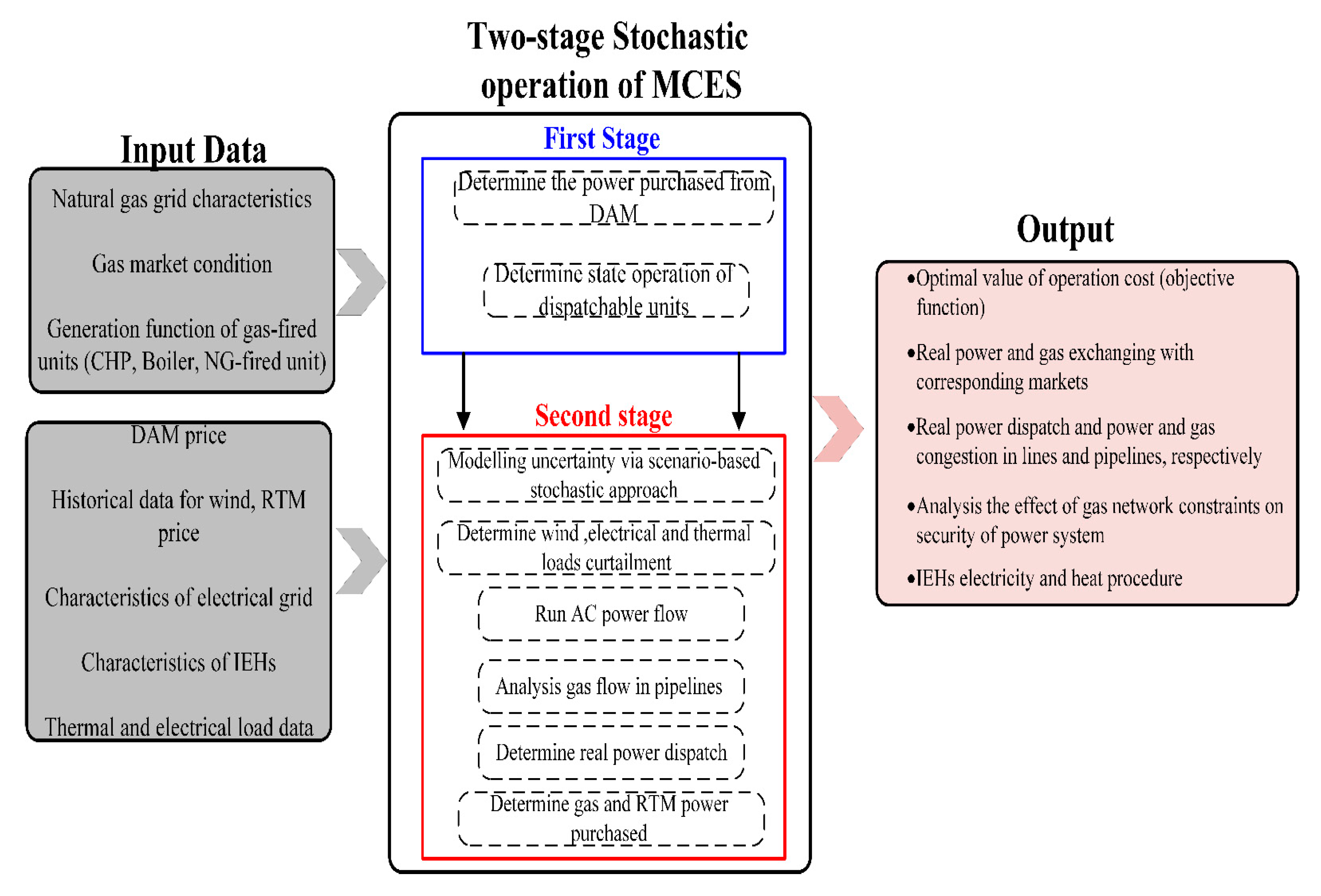
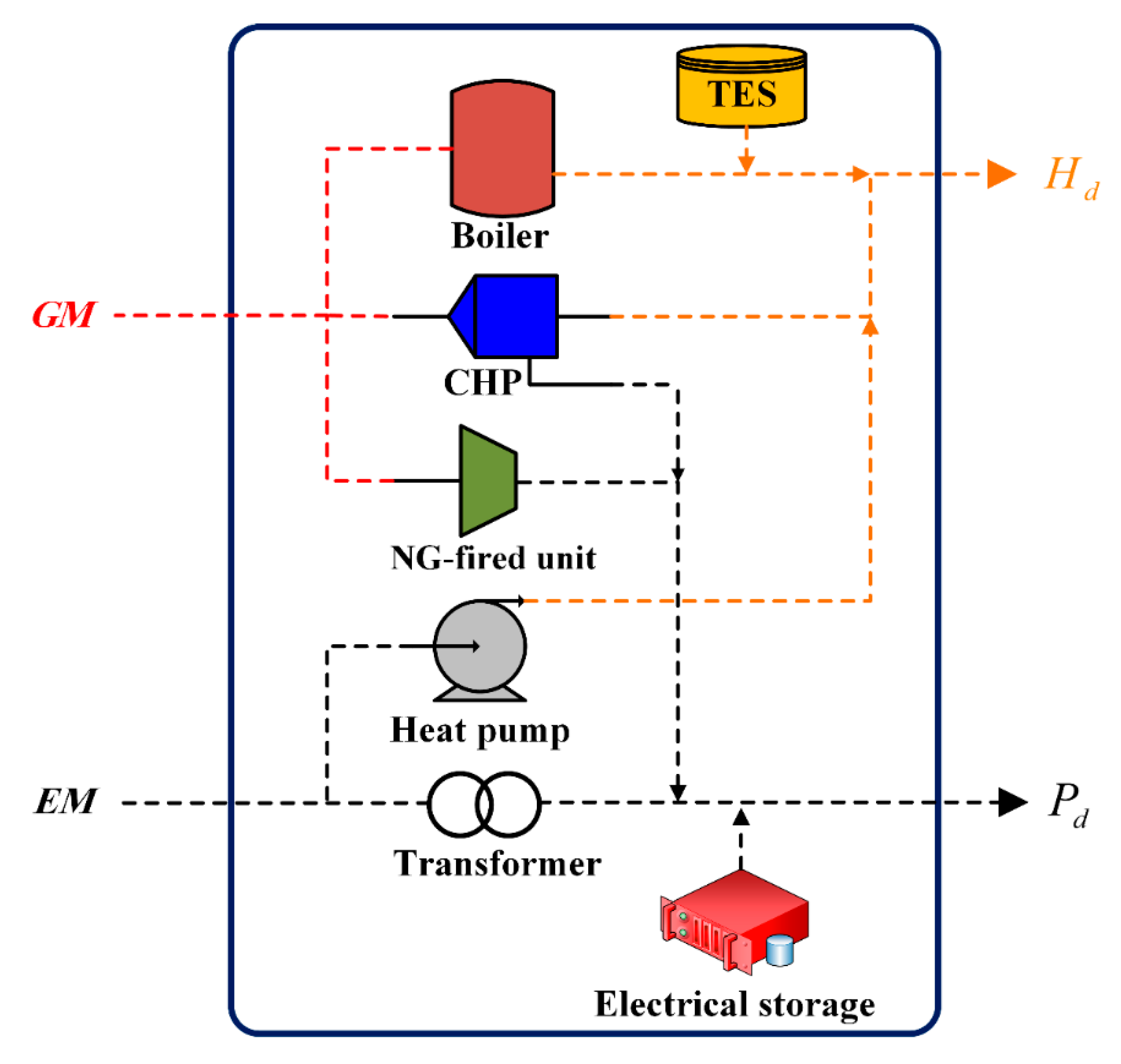


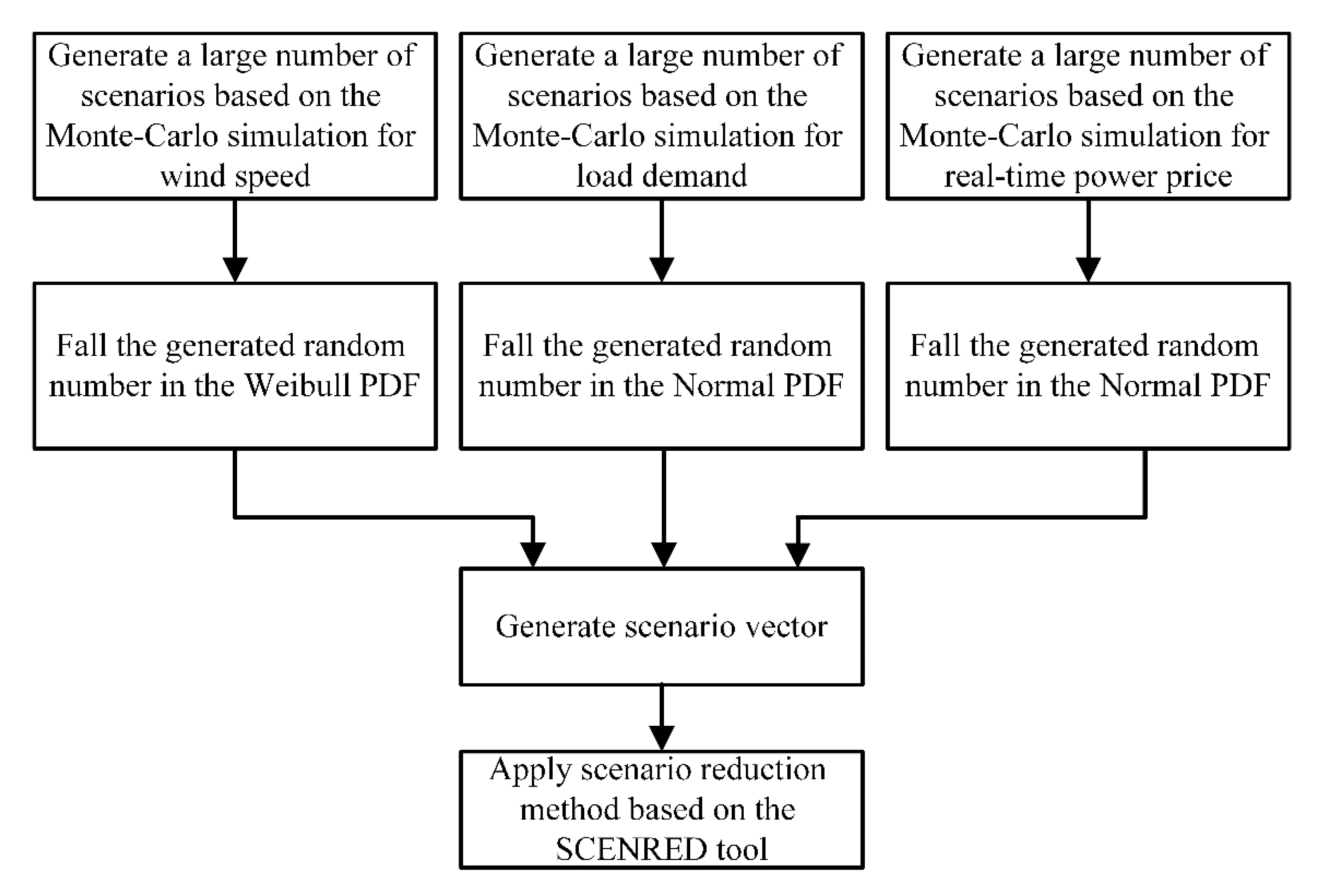
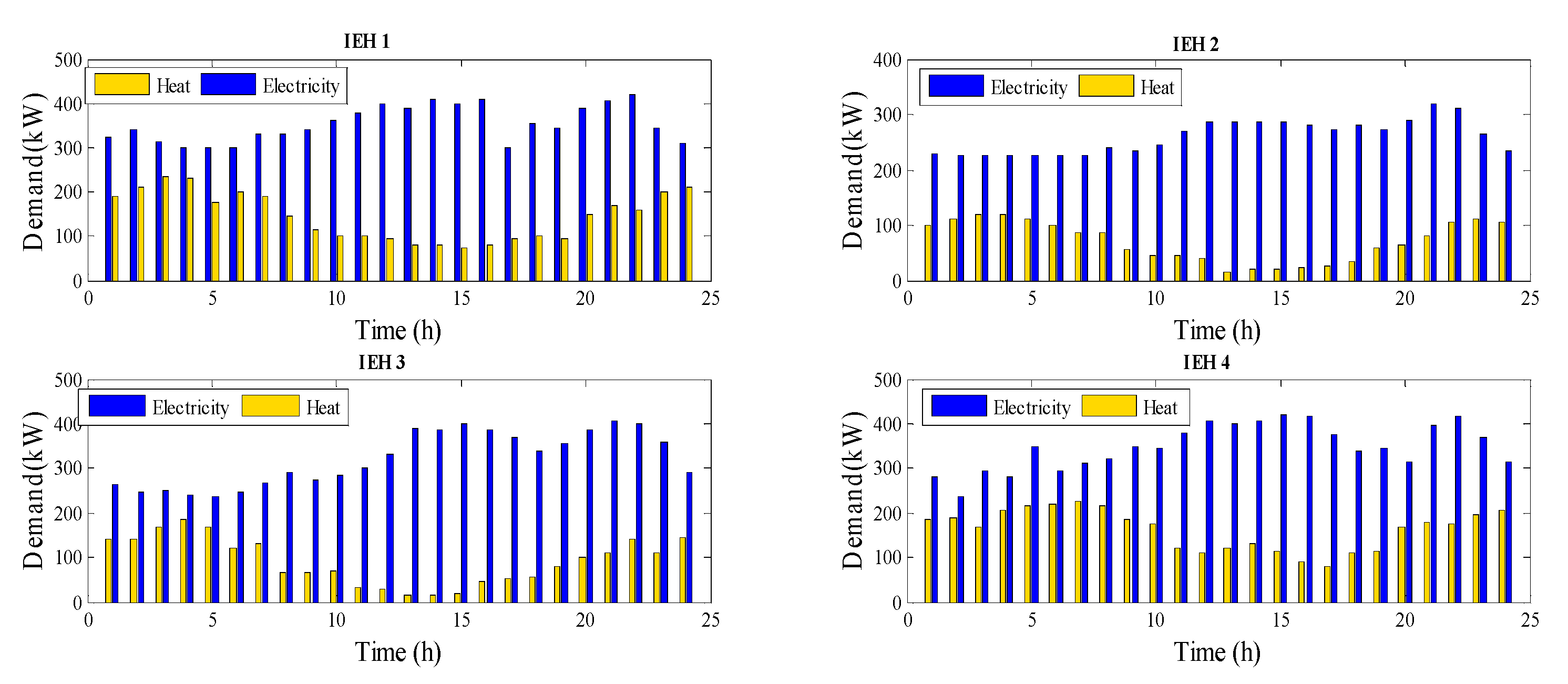
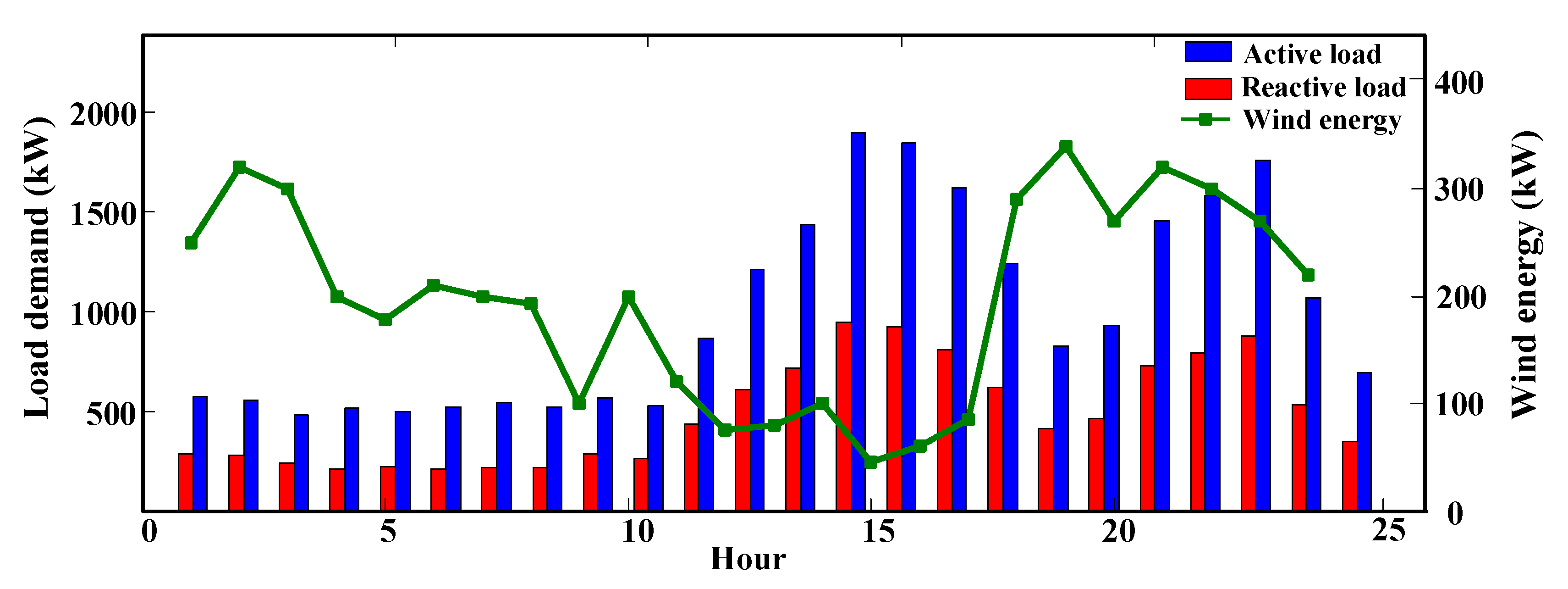
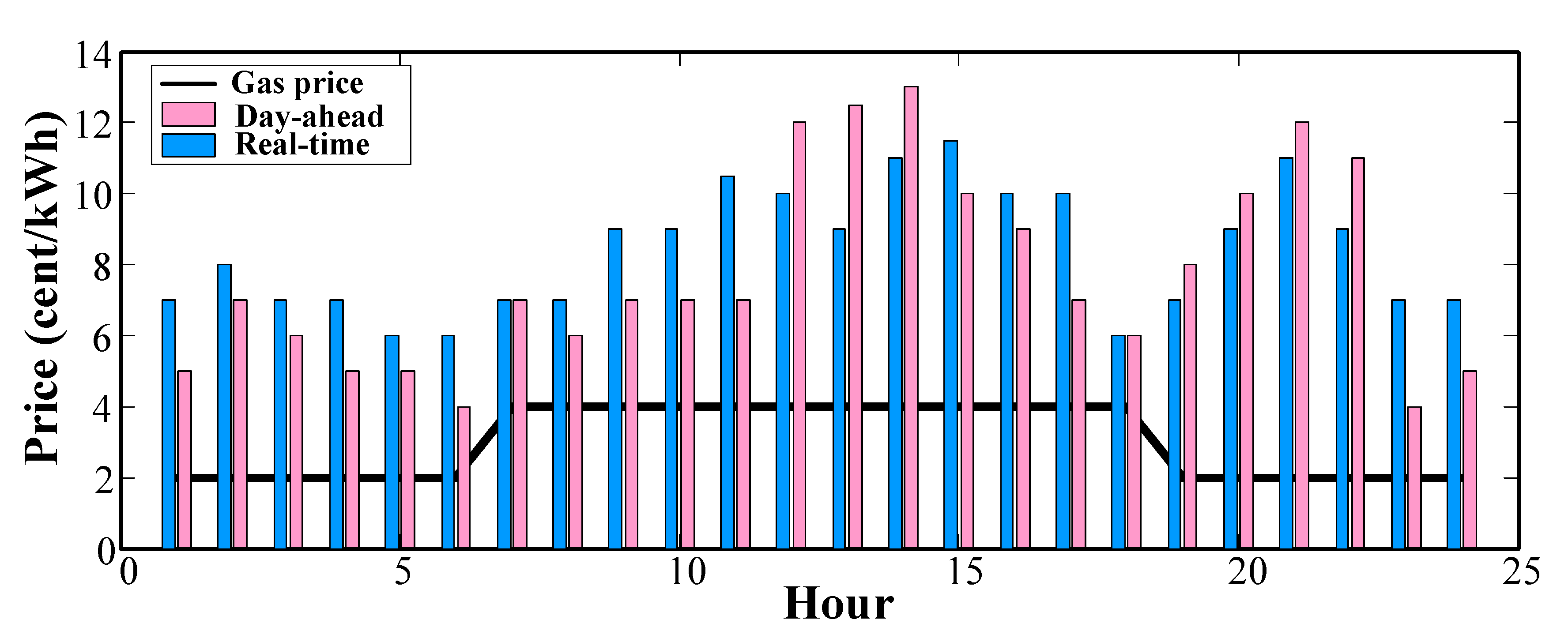

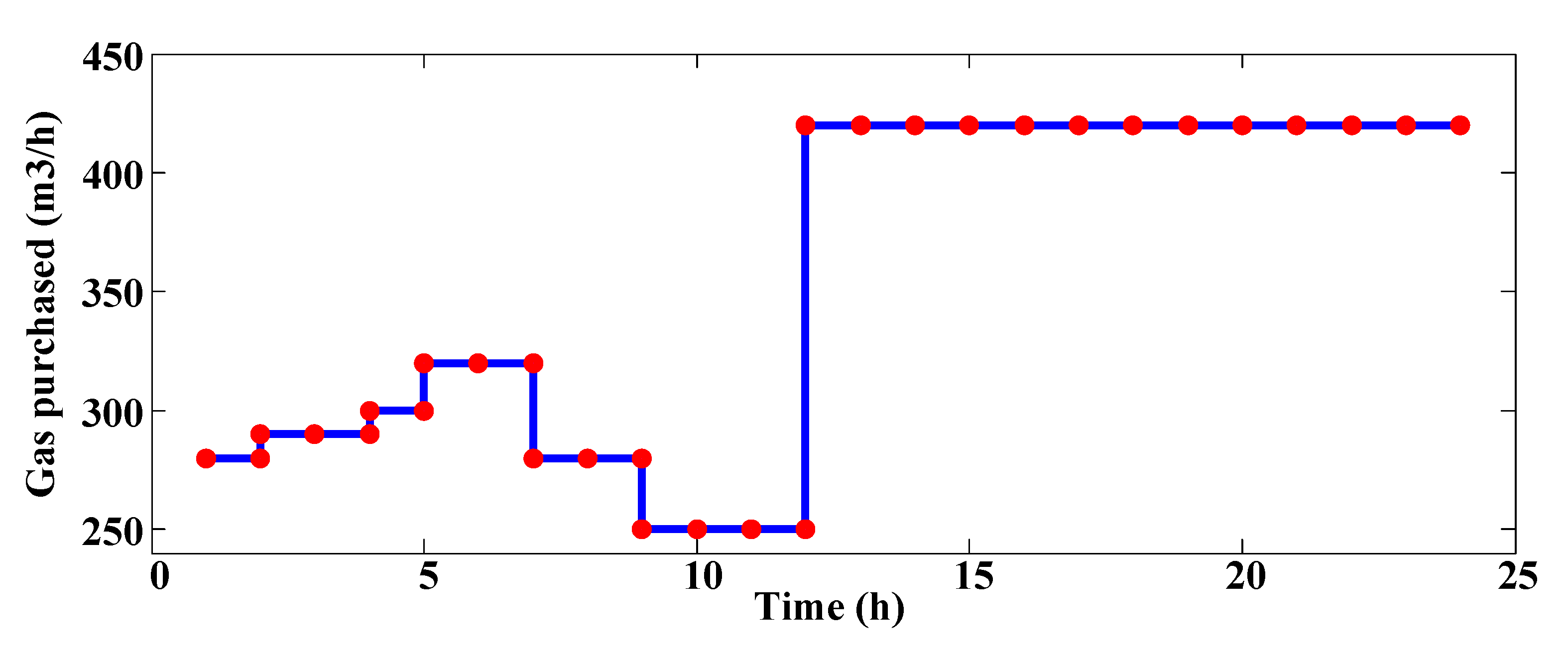
| Works | Integrated Gas-Electricity Scheduling | Network Constrained | Considering IEH | Participating in Markets | Existing Uncertainty | Uncertainty Modeling | |||
|---|---|---|---|---|---|---|---|---|---|
| Day-Ahead | Real-Time | Wind | Load | Price | |||||
| [11] | ✓ | ✓ | × | ✓ | × | ✓ | × | × | Robust |
| [17] | ✓ | ✓ | × | × | × | ✓ | ✓ | × | Stochastic |
| [19] | ✓ | ✓ | × | ✓ | × | ✓ | × | Stochastic | |
| [44] | ✓ | × | × | × | ✓ | ✓ | ✓ | Stochastic | |
| [45] | ✓ | × | ✓ | ✓ | × | ✓ | ✓ | × | Robust |
| Our work | ✓ | ✓ | ✓ | ✓ | ✓ | ✓ | ✓ | ✓ | Two-stage stochastic |
| Hub | Component | ||||||
|---|---|---|---|---|---|---|---|
| CHP | Gas Boiler | NG-Fired Unit | Heat Pump | TES | Transformer | Battery | |
| IEH 1 | ✓ | ✓ | ✓ | ✓ | ✓ | ✓ | ✓ |
| IEH 2 | × | ✓ | ✓ | ✓ | ✓ | ✓ | ✓ |
| IEH 3 | ✓ | ✓ | ✓ | ✓ | ✓ | ✓ | × |
| IEH 4 | ✓ | ✓ | ✓ | × | ✓ | ✓ | ✓ |
| CHP | 0/250 | 1/1 | 10 |
| NG-fired unit | 0/200 | 1/1 | 10 |
| Battery | 20/250 | 50/50 | 0.8/0.9 |
| TES | 50/500 | 100/100 | 0.8/0.9 |
| Boiler | 0 | 45 | 0.8 |
| Heat pump | 135 | 2 |
| Scenario | Operation Cost ($) | Probability |
|---|---|---|
| 1 | 5916.332 | 0.0321 |
| 2 | 5858.411 | 0.1376 |
| 3 | 5780.233 | 0.1991 |
| 4 | 5998.824 | 0.1076 |
| 5 | 6174.91 | 0.1402 |
| 6 | 6102.51 | 0.0352 |
| 7 | 6099.244 | 0.1322 |
| 8 | 6260.641 | 0.1333 |
| 9 | 6001.257 | 0.0225 |
| 10 | 5968.063 | 0.0602 |
| Expected cost ($) | 6016.0425 |
| Electricity Energy Scheduling | Thermal Energy Scheduling | |||||||
|---|---|---|---|---|---|---|---|---|
| Hour | Power to Upstream Bus | Power by CHP | Power by NG-Fired | Battery Schedule | Heat by CHP | Heat by Boiler | Heat Pump | TES Schedule |
| 1 | 0 | 0 | 200 | −50 | 0 | 80 | 135 | −25 |
| 2 | 0 | 0 | 200 | −50 | 87.5 | 80 | 135 | −90 |
| 3 | 0 | 0 | 200 | −50 | 87.5 | 80 | 135 | −67 |
| 4 | 0 | 0 | 200 | 0 | 87.5 | 80 | 135 | −72 |
| 5 | 0 | 0 | 200 | 0 | 0 | 80 | 135 | −40 |
| 6 | 0 | 0 | 200 | 0 | 0 | 80 | 135 | −15 |
| 7 | 0 | 0 | 200 | −50 | 0 | 80 | 45 | 65 |
| 8 | 0 | 83.5 | 200 | −50 | 87.5 | 0 | 45 | 0 |
| 9 | 0 | 83.5 | 200 | 0 | 87.5 | 0 | 45 | 0 |
| 10 | 0 | 83.5 | 200 | 0 | 0 | 0 | 45 | 65 |
| 11 | 0 | 83.5 | 200 | 0 | 0 | 0 | 45 | 65 |
| 12 | 0 | 150 | 200 | 50 | 0 | 80 | 0 | 0 |
| 13 | 110 | 250 | 200 | 50 | 0 | 80 | 0 | 0 |
| 14 | 90 | 250 | 200 | 50 | 0 | 80 | 0 | 0 |
| 15 | 50 | 250 | 200 | 0 | 0 | 80 | 0 | 0 |
| 16 | 0 | 150 | 200 | −25 | 0 | 80 | 0 | 0 |
| 17 | 0 | 83.5 | 200 | −25 | 0 | 0 | 0 | 95 |
| 18 | 0 | 0 | 200 | 0 | 0 | 0 | 45 | 65 |
| 19 | 0 | 0 | 200 | 0 | 0 | 0 | 45 | 50 |
| 20 | 0 | 150 | 200 | 0 | 87.5 | 80 | 0 | 0 |
| 21 | 95 | 250 | 200 | 50 | 87.5 | 80 | 0 | 0 |
| 22 | 80 | 250 | 200 | 50 | 87.5 | 80 | 0 | 0 |
| 23 | 0 | 0 | 200 | 0 | 87.5 | 0 | 135 | 0 |
| 24 | 0 | 0 | 200 | 0 | 87.5 | 0 | 135 | 0 |
| Electricity Energy Scheduling | Thermal Energy Scheduling | ||||
|---|---|---|---|---|---|
| Hour | Power by NG-Fired | Battery Schedule | Heat by Boiler | Heat Pump | TES Schedule |
| 1 | 150 | −25 | 0 | 135 | −35 |
| 2 | 150 | −25 | 0 | 135 | −25 |
| 3 | 150 | −50 | 80 | 135 | −95 |
| 4 | 150 | 0 | 80 | 135 | −95 |
| 5 | 150 | 0 | 0 | 135 | 25 |
| 6 | 150 | 0 | 0 | 135 | −35 |
| 7 | 150 | −50 | 80 | 0 | 0 |
| 8 | 150 | 0 | 80 | 45 | −40 |
| 9 | 150 | 0 | 40 | 0 | 15 |
| 10 | 150 | 0 | 0 | 0 | 45 |
| 11 | 150 | 0 | 0 | 0 | 45 |
| 12 | 150 | 0 | 0 | 0 | 40 |
| 13 | 150 | 50 | 0 | 0 | 15 |
| 14 | 150 | 50 | 0 | 0 | 20 |
| 15 | 150 | 50 | 0 | 0 | 20 |
| 16 | 150 | 50 | 0 | 0 | 22 |
| 17 | 150 | 0 | 0 | 0 | 25 |
| 18 | 150 | 0 | 0 | 0 | 35 |
| 19 | 150 | 0 | 60 | 0 | 0 |
| 20 | 150 | 0 | 65 | 0 | 0 |
| 21 | 150 | 50 | 80 | 0 | 0 |
| 22 | 150 | 0 | 65 | 0 | 40 |
| 23 | 150 | −50 | 0 | 110 | 0 |
| 24 | 150 | −50 | 0 | 110 | 0 |
| Electricity Energy Scheduling | Thermal Energy Scheduling | ||||||
|---|---|---|---|---|---|---|---|
| Hour | Power to Upstream Bus | Power by CHP | Power by NG-Fired | Heat by CHP | Heat by Boiler | Heat Pump | TES Schedule |
| 1 | 0 | 0 | 150 | 0 | 65 | 135 | −60 |
| 2 | 0 | 0 | 150 | 0 | 65 | 135 | −60 |
| 3 | 0 | 0 | 150 | 0 | 80 | 135 | −45 |
| 4 | 0 | 0 | 150 | 0 | 80 | 135 | −30 |
| 5 | 0 | 0 | 150 | 0 | 80 | 135 | −45 |
| 6 | 0 | 0 | 150 | 0 | 0 | 135 | 0 |
| 7 | 0 | 0 | 150 | 0 | 0 | 135 | 0 |
| 8 | 0 | 0 | 150 | 0 | 0 | 0 | 67 |
| 9 | 0 | 0 | 150 | 0 | 0 | 0 | 67 |
| 10 | 0 | 0 | 150 | 0 | 0 | 0 | 70 |
| 11 | 0 | 83.5 | 150 | 87.5 | 0 | 0 | 32 |
| 12 | 0 | 180 | 150 | 112.5 | 0 | 0 | 0 |
| 13 | 60 | 250 | 200 | 0 | 0 | 0 | 15 |
| 14 | 65 | 250 | 200 | 0 | 0 | 0 | 15 |
| 15 | 50 | 250 | 200 | 0 | 0 | 0 | 20 |
| 16 | 64 | 250 | 200 | 0 | 0 | 45 | 0 |
| 17 | 0 | 83.5 | 200 | 87.5 | 0 | 45 | 0 |
| 18 | 0 | 0 | 200 | 0 | 0 | 55 | 0 |
| 19 | 0 | 83.5 | 200 | 87.5 | 80 | 0 | 0 |
| 20 | −65 | 250 | 200 | 0 | 80 | 0 | 20 |
| 21 | 45 | 250 | 200 | 0 | 80 | 30 | 0 |
| 22 | 49 | 250 | 200 | 05 | 80 | 60 | 0 |
| 23 | 0 | 83.5 | 200 | 87.5 | 0 | 110 | 0 |
| 24 | 0 | 0 | 200 | 0 | 0 | 135 | 10 |
| Electricity Energy Scheduling | Thermal Energy Scheduling | ||||||
|---|---|---|---|---|---|---|---|
| Hour | Power to Upstream Bus | Power by CHP | Power by NG-Fired | Battery Schedule | Heat by CHP | Heat by Boiler | TES Schedule |
| 1 | 0 | 0 | 200 | −50 | 0 | 80 | −10 |
| 2 | 0 | 0 | 200 | −35 | 87.5 | 80 | −15 |
| 3 | 0 | 0 | 200 | −50 | 87.5 | 80 | −15 |
| 4 | 0 | 0 | 200 | 0 | 87.5 | 80 | 0 |
| 5 | 0 | 0 | 200 | 0 | 0 | 80 | 39 |
| 6 | 0 | 0 | 200 | 0 | 0 | 80 | 42 |
| 7 | 0 | 0 | 200 | 0 | 0 | 80 | 45 |
| 8 | 0 | 0 | 200 | 0 | 87.5 | 80 | 43 |
| 9 | 0 | 0 | 200 | 0 | 87.5 | 80 | 0 |
| 10 | 0 | 0 | 200 | 0 | 0 | 80 | 0 |
| 11 | 0 | 0 | 200 | 50 | 0 | 80 | −40 |
| 12 | 0 | 0 | 200 | 35 | 0 | 80 | −70 |
| 13 | 0 | 0 | 200 | 0 | 0 | 80 | −70 |
| 14 | 95 | 250 | 200 | 50 | 0 | 80 | 0 |
| 15 | 30 | 250 | 200 | 0 | 0 | 80 | 0 |
| 16 | 0 | 250 | 200 | 0 | 0 | 80 | 0 |
| 17 | 0 | 250 | 200 | −50 | 0 | 80 | 0 |
| 18 | 0 | 0 | 200 | −50 | 0 | 80 | 30 |
| 19 | 0 | 0 | 200 | 0 | 0 | 80 | −53 |
| 20 | 0 | 0 | 200 | 0 | 87.5 | 80 | 0 |
| 21 | 105 | 250 | 200 | 50 | 87.5 | 80 | 70 |
| 22 | 85 | 250 | 200 | 50 | 87.5 | 80 | 70 |
| 23 | 0 | 0 | 200 | 0 | 87.5 | 80 | −30 |
| 24 | 0 | 0 | 200 | 0 | 87.5 | 80 | −30 |
© 2020 by the authors. Licensee MDPI, Basel, Switzerland. This article is an open access article distributed under the terms and conditions of the Creative Commons Attribution (CC BY) license (http://creativecommons.org/licenses/by/4.0/).
Share and Cite
Hemmati, M.; Abapour, M.; Mohammadi-Ivatloo, B.; Anvari-Moghaddam, A. Optimal Operation of Integrated Electrical and Natural Gas Networks with a Focus on Distributed Energy Hub Systems. Sustainability 2020, 12, 8320. https://doi.org/10.3390/su12208320
Hemmati M, Abapour M, Mohammadi-Ivatloo B, Anvari-Moghaddam A. Optimal Operation of Integrated Electrical and Natural Gas Networks with a Focus on Distributed Energy Hub Systems. Sustainability. 2020; 12(20):8320. https://doi.org/10.3390/su12208320
Chicago/Turabian StyleHemmati, Mohammad, Mehdi Abapour, Behnam Mohammadi-Ivatloo, and Amjad Anvari-Moghaddam. 2020. "Optimal Operation of Integrated Electrical and Natural Gas Networks with a Focus on Distributed Energy Hub Systems" Sustainability 12, no. 20: 8320. https://doi.org/10.3390/su12208320
APA StyleHemmati, M., Abapour, M., Mohammadi-Ivatloo, B., & Anvari-Moghaddam, A. (2020). Optimal Operation of Integrated Electrical and Natural Gas Networks with a Focus on Distributed Energy Hub Systems. Sustainability, 12(20), 8320. https://doi.org/10.3390/su12208320







